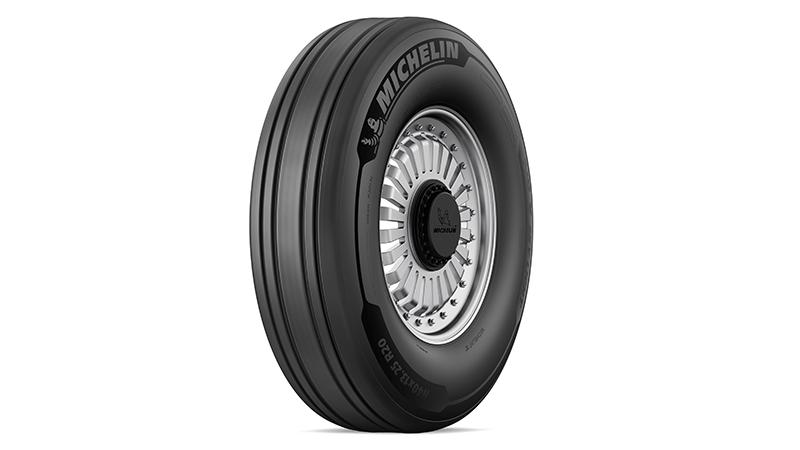This article is published in Aviation Week & Space Technology and is free to read until Apr 27, 2025. If you want to read more articles from this publication, please click the link to subscribe.

Michelin says its Air X Sky Light tire could save more than 550 lb. on an Airbus A350.
Dassault’s new Falcon 10X business jet boasts technical advances from tip to tail. One of the most inconspicuous is perhaps the most progressive: Its tires.
Michelin’s Air X Sky Light tires are a departure from conventional designs. The French company has developed a radial tire that weighs 10-20% less than comparable models, depending on the aircraft, and lasts up to 20% longer, as measured in landings per tread (LPT).
Unveiled at the 2023 Paris Air Show, the Air X Sky Light required innovations in multiple phases of Michelin’s tire design and production processes, says Alicia Teillot, vice president of marketing and communication for the company’s aircraft business line.
“It combines a crown architecture—or tread area—and an optimized footprint to extend the lifespan by 10-20% compared to the previous tires’ generations,” she explains. The improvements rely on “ultra-resistant casing materials as well as latest-generation hybrid cables and fabrics” that strengthen and reinforce the tire’s construction, she adds.
Along the bead, or the part of the tire that comes in contact with the rim, lighter materials help the tire weigh less.
Radial tires are already optimized to minimize weight and optimize strength. In a radial tire, its plies, or internal reinforcing layers, run perpendicular to the tire’s centerline, from bead to bead.
In a bias-ply tire, the layers run in alternating diagonal patterns from bead to bead. This adds strength but also weight.
The differences lead to trade-offs. Radial tires are lighter and offer more LPT, while bias-ply tires have more retread lives.
Michelin eliminates this issue on the Air X Sky Light by omitting the retread option. The company’s rationale extends well beyond any individual operator’s bottom line.
“For the design of this tire, we used the life-cycle assessment approach,” Teillot explains.
That meant looking at the five key phases of a tire’s life: design and raw materials, manufacturing, logistics, use and end of life. The company determined that 95% of a tire’s environmental impact comes during its use phase, or service life. “This is mainly impacted by the tire’s mass,” Teillot says.
Operators burn less fuel hauling around lighter tires, which saves money and is more environmentally friendly.
“The environmental benefit generated by mass savings is far greater than that generated by the raw material savings of a retreadable tire,” Teillot says. “We have chosen to focus on substantial weight savings” for the Air X Sky Light. “As a result, it cannot be retreaded.”
While trimming a tire’s weight 20% may not sound like much, the benefits add up. On a Boeing 737 or Airbus A320, the Air X Sky Light could save 165 lb. On an Airbus A350, the savings grows to more than 550 lb.
“Consequently, for a fleet of 40 long-haul aircraft, the weight reduction in the tires alone could [save] $840,000 in jet fuel per year and over 3,600 tons of CO2 equivalent,” Teillot says. “For a fleet of 100 medium-haul aircraft, the jet fuel savings would be $600,000, with a reduction of 2,200 metric tons of CO2 over one year.”
The Air X Sky Light is expected to enter service in 2027 on the first Falcon 10X. But Michelin plans to expand the product line based on demand.
“Air X Sky Light is aimed at the commercial aviation market,” Teillot says. “The choice of the next tire dimensions will be defined with regard to the priorities of airlines and aircraft manufacturers.”
Subsequent models could be developed for both line-fit and retrofit applications, depending on demand and agreements with manufacturers and operators.
Developing a new tire size takes 2-3 years, Teillot says.





